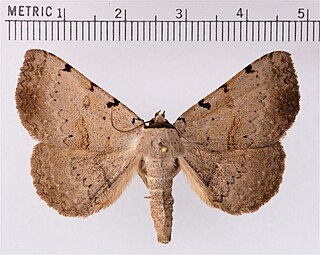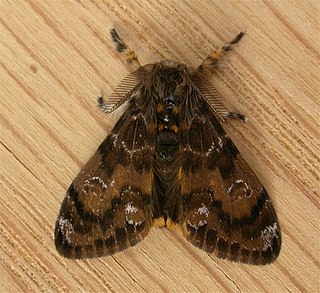
The Lymantriinae are a subfamily of moths of the family Erebidae. The taxon was erected by George Hampson in 1893.

Noctuoidea is the superfamily of noctuid or "owlet" moths, and has more than 70,000 described species, the largest number of for any Lepidopteran superfamily. Its classification has not yet reached a satisfactory or stable state. Since the end of the 20th century, increasing availability of molecular phylogenetic data for this hugely successful radiation has led to several competing proposals for a taxonomic arrangement that correctly represents the relationships between the major lineages.

The Catocalini are a tribe of moths in the family Erebidae. Adults of many species in the tribe are called underwing moths due to their vividly colored hindwings that are often covered by contrastingly dark, drab forewings.

The Calpinae are a subfamily of moths in the family Erebidae described by Jean Baptiste Boisduval in 1840. This subfamily includes many species of moths that have a pointed and barbed proboscis adapted to piercing the skins of fruit to feed on juice, and in the case of the several Calyptra species of vampire moths, to piercing the skins of mammals to feed on blood. The subfamily contains some large moths with wingspans longer than 5 cm (2 in).

The Ctenuchina are a subtribe of moths in the family Erebidae.
Cifuna is a genus of tussock moths in the family Erebidae. The genus was erected by Francis Walker in 1855.
Clethrogyna is a genus of tussock moths in the family Erebidae. The genus was described by Rambur in 1866.

Daplasa is a genus of moths in the subfamily Lymantriinae of the family Erebidae erected by Frederic Moore in 1879. It is the sole member of the tribe Daplasini erected Jeremy Daniel Holloway and Houshuai Wang in 2015.

Teia is a genus of tussock moths in the family Erebidae first described by Francis Walker in 1855.
Telochurus is a genus of tussock moths in the family Erebidae erected by Koen V. N. Maes in 1984.

Arctornis jonasii is a moth in the family Erebidae, originally placed in its own genus, Topomesoides, which was synonymized with Arctornis in 2015. It was first described by Arthur Gardiner Butler in 1877.

The Erebidae are a family of moths in the superfamily Noctuoidea. The family is among the largest families of moths by species count and contains a wide variety of well-known macromoth groups. The family includes the underwings (Catocala); litter moths (Herminiinae); tiger, lichen, and wasp moths (Arctiinae); tussock moths (Lymantriinae), including the arctic woolly bear moth ; piercing moths ; micronoctuoid moths (Micronoctuini); snout moths (Hypeninae); and zales, though many of these common names can also refer to moths outside the Erebidae. Some of the erebid moths are called owlets.

The Erebinae are a subfamily of moths in the family Erebidae erected by William Elford Leach in 1815. Erebine moths are found on all continents except Antarctica, but reach their greatest diversity in the tropics. While the exact number of species belonging to the Erebinae is not known, the subfamily is estimated to include around 10,000 species. Some well-known Erebinae include underwing moths (Catocala) and witch moths (Thermesiini). Many of the species in the subfamily have medium to large wingspans, up to nearly 30 cm in the white witch moth, which has the widest wingspan of all Lepidoptera. Erebine caterpillars feed on a broad range of plants; many species feed on grasses and legumes, and a few are pests of castor bean, sugarcane, rice, as well as pistachios and blackberries.

Clethrogyna antiquoides is a moth of the family Erebidae. It is found in most of Europe, the Ural, Armenia, Mongolia, and China. This species has commonly been placed in the genus Orgyia but molecular analyses support the genus Clethrogyna as a separate lineage.
The Catephiini are a tribe of moths in the family Erebidae.

The Acantholipini are a tribe of moths in the family Erebidae.

The Euclidiini are a tribe of moths in the family Erebidae. The tribe was erected by Achille Guenée in 1852.
The Hulodini are a tribe of moths in the family Erebidae.

Canini is a taxonomic rank which represents the dog-like tribe of the subfamily Caninae, and is sister to the fox-like tribe Vulpini. The Canini came into existence 9 million years ago. This group was first represented by Eucyon, mostly by Eucyon davisi that was spread widely across North America and is basal to the other members of the tribe. Its members are informally known as true dogs.
Kuromondokuga is a genus of tussock moths in the family Erebidae erected by Yasunori Kishida in 2011.













